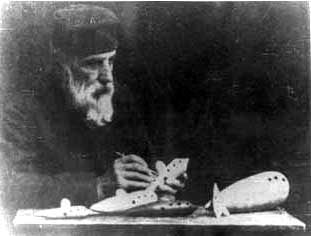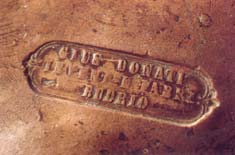|
The ocarina belongs to a very old family of instruments, believed to date back over 12,000 years, with varied versions made of bone, clay, wood and other materials. Many cultures have used them for song and dance. Variations have come from China, Japan, the Americas and they came to Europe via the trade routes of Eurasia.  Giuseppe Donati Giuseppe Donati The modern Ocarina used throughout the world today was invented in Budrio, Italy, during the mid-nineteenth century by Giuseppe Donati. Its shape recalls the elongated ovoid profile of a goose (oca in Italian) without the head: the name is derived from ucarina, diminutive of oca in Bolognese dialect.  Donati invented the modern version of the ocarina in 1853 at 17 years old. Donati built a variety of large and small ocarinas tuned to each other, making it possible to place in concert with each other. Donati had made five ocarinas of different sizes, each having holes for all ten fingers, which ranged from bass and treble, an extension of notes tuned to the piano. With the help of other musicians, he assembled the "Concert of Ocarinas", each evening performing around town playing in taverns and private houses. The haunting sound of a vintage, bass ocarina is played in this video. The town of Budrio in the province of Bologna hosts the International Ocarina Festival each year in early spring. It's an event dedicated to the sound and atmosphere created by the ocarina, with the participation of guest musicians and makers from all over the world. The Festival is organized by the municipal district of Budrio with concerts, musical entertainment on the streets, exhibits, folk dancing and many other activities. This video shows the possibilities of using the ocarina for complex, classical musical performances, with a full range of octaves available for each musician.
 The Calabrian Lira (lyre) is a bowed string instrument with three strings. Like most bowed lyres and psalterys, it is played upright, usually supported on the knee, held with the left hand touching the strings with the nails laterally while the right hand moves the bow. Traditional songs of the Lira include accompaniment songs (e.g. serenades and songs of anger) and songs suitable for dancing (tarantellas). These songs and tunes are passed on from older players to the young. In recent years there has been a resurgence of Italian folk music from many regions of Italy, with newer musical traditional folkloric music groups and performers. There has also been more and more craftsmen in Calabria building these instruments.  The Calabrian Lira is closely related to the bowed Lira of the Byzantine Empire, first noted by a 9th century Persian geographer and spreading to eastern Europe in the 11th and 12th centuries. The video below visits a Lira maker in his workshop... Mi Votu E Mi Rivotu (I Turn and Turn)
performed by Manunura This is one of the most beautiful love songs of Sicilian folk music. Famously known after the rendition by Sicilian singer Rosa Balistreri, she claimed to have heard this song sing for the first time inside the prison of Palermo, and has attributed to a prisoner the composition. In reality the lyrics of this song is very old and is present in many collections of Sicilian songs. It appeared in the collection that Lionardo Vigo Calanna, Marquis of Gallodoro, published in 1870 under the title "Raccolta Amplissima di Canti Siciliani", produced after a 20-year-long work of research and collection. English lyrics: I turn and turn again sighing I spend whole nights awake I admire your beauty and see the whole night pass until dawn Because of you now I no longer sleep My aching heart has no more peace Do you know when I'll leave you? When my life ends and I'll die O dove, walking along the seashore, stop that I must ask you a couple words stop so I can take a plume off your wings to write letters to my love. I write you letters, two, three But never a reply from you I receive Have you not paper to write or you cannot write? I turn and turn again sighing I spend whole nights without sleeping |
Categories
All
Archives
July 2023
|





